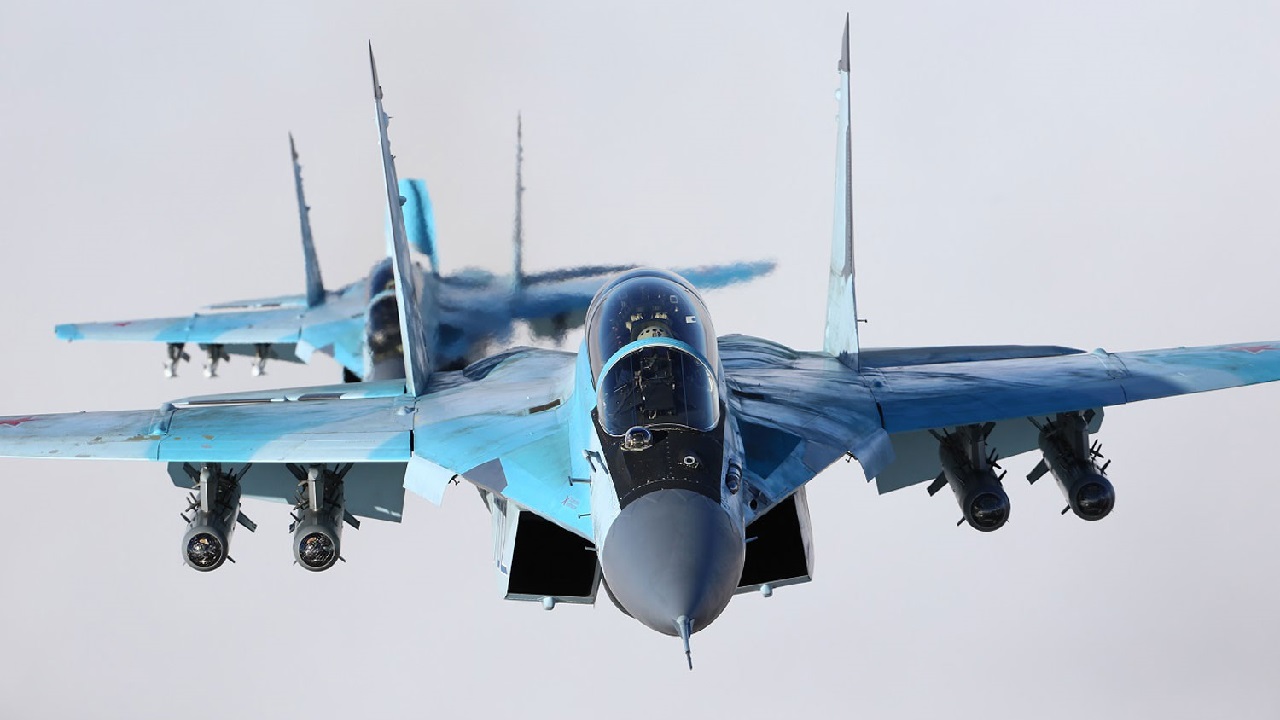What happened to Russia’s MiG-35? Hyped as a fourth-generation “plus-plus” fighter that would give the Russian air force needed punch and enviable combat presence for export, only 30 of the Fulcrums have been made since 2019.
This conundrum has been going on since 2020 when at the time the Russians only ordered six airplanes. This program is starting to look like a boondoggle that failed to make a splash domestically or in the export market. Let’s unpeel the mysterious onion that is the MiG-35 Fulcrum.
The Outgrowth of the MiG-29
The MiG-35 is based on a MiG-29 design and two MiG-29 variants – the K and M. The Fulcrum took its initial flight in 2016. The MiG-35 is meant to be a multi-role fighter able to take on air superiority, intercept enemy fighters, strike ground targets, and perform reconnaissance missions. The MiG-35 boasts a passive electronically scanned array and electro-optical sensors with the ability to track multiple in-air, sea, and ground targets.
Quality Engines Give it Substantial Speed and Thrust
Powered by two FADEC RD-33MK turbofan engines, the MiG-35 has a maximum speed of Mach 2.25 and a 52,000-foot service ceiling. The modern engines offer high maneuverability and “are equipped with failure detection systems, compressor speed governors and LP turbine exit temperature limiter, surge, ice and fire detectors,” according to Rosoboronexport.
Should Be Pilot-Friendly
The MiG-35’s cockpit is up to date. It features three color liquid-crystal displays and a helmet-mounted display. The pilot has a missile approach warning system with 360 degrees of coverage. The airplane includes optional electronic warfare capabilities that can jam enemy radar.
Full Suite of Weapons
The MiG-35 contains modern munitions such as air-to-air missiles. These armaments include the RVV-SD, an updated R-77, and the Kh-38 air-to-ground missile. Precision-guided bombs and dumb bombs can also be dropped.
Customers Are Looking Elsewhere
With all these enviable characteristics, the MiG-35 should be dominating the skies over Ukraine or emerging as a hit on the export market – or both. That has not come to pass. India and Egypt were interested in the MiG-35 but ended up not making the purchase. The MiG-35 is going up against substantial competition from the French Rafale, the American F/A-18, F-16 and F-15, the Eurofighter Typhoon, and the Saab Gripen.
Developing Nations Don’t Have the Money or Inclination to Buy
Argentina, Bangladesh, and Malaysia have kicked the tires too, but these are minor air forces in countries with limited budgets. It would make the most sense for Malaysia to buy the MiG-35 since they have China to worry about. The Malaysians had MiG-29s but could not get spare parts from Russia, and they are expensive to keep airborne. MiG-35s are considered too pricey and high maintenance for the Malaysian military.
MiG-35 also does not have a combat record, since it is a relatively new airplane. F-16s, alternatively, have enjoyed broad combat success over the decades and are less expensive than the MiG-35. Countries also worry about getting spare parts from Russia as many suppliers are under international financial sanctions.
Getting Lost in the Shuffle
The development of the MiG-35 is a cautionary tail in that it is trying to penetrate an export market in which customers have many choices. Some specs are robust, especially when it comes to radar and sensors in addition to a powerful engine. Maintenance is a problem for a fighter with such modern accessories. Potential customers must be concerned with the cost of maintaining the airplane without readily available spare parts. The other problem for the future of the MiG-35 is the emergence of the Su-57 and Su-75 – both fighters with stealth characteristics that can outclass the MiG-35. So, the MiG-35 has a challenging future ahead of it – not ready for domestic use or export market growth.
Now serving as 1945’s Defense and National Security Editor, Brent M. Eastwood, PhD, is the author of Humans, Machines, and Data: Future Trends in Warfare. He is an Emerging Threats expert and former U.S. Army Infantry officer. You can follow him on Twitter @BMEastwood.

